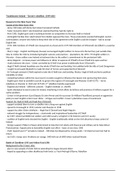Summary
Summary Tudors Depth Study Edexcel History - Troublesome Ireland Tyrones rebellion
- Course
- Institution
- Book
This revision summary contains all the key points that you need to know about Tyrone's rebellion in the Tudors. It follows the demands of the specification but in a much easier way to understand. I found it useful to try and understand the events that occurred.
[Show more]




